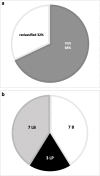"Re-evaluation of variants of uncertain significance in patients with hereditary arrhythmogenic disorders"
- PMID: 39068400
- PMCID: PMC11282671
- DOI: 10.1186/s12872-024-04065-w
"Re-evaluation of variants of uncertain significance in patients with hereditary arrhythmogenic disorders"
Erratum in
-
Correction: "Re-evaluation of variants of uncertain significance in patients with hereditary arrhythmogenic disorders".BMC Cardiovasc Disord. 2024 Nov 1;24(1):609. doi: 10.1186/s12872-024-04286-z. BMC Cardiovasc Disord. 2024. PMID: 39482628 Free PMC article. No abstract available.
Abstract
Background: Genetic diagnostics support the diagnosis of hereditary arrhythmogenic diseases, but variants of uncertain significance (VUS) complicate matters, emphasising the need for regular reassessment. Our study aims to reanalyse rare variants in different genes in order to decrease VUS diagnoses and thus improve risk stratification and personalized treatment for patients with arrhythmogenic disorders.
Methods: Genomic DNA was analysed using Sanger sequencing and next-generation sequencing (NGS). The Data was evaluated using various databases and in silico prediction tools and classified according to current ACMG standards by two independent experts.
Results: We identified 53 VUS in 30 genes, of which 17 variants (32%) were reclassified. 13% each were downgraded to likely benign (LB) and benign (B) and 6% were upgraded to likely pathogenic (LP). Reclassifications mainly occurred among variants initially classified in 2017-2019, with rates ranging from 50 to 60%.
Conclusion: The results support the assumption that regular reclassification of VUS is important, as it provides new insights for genetic diagnostics, that benefit patients and guide therapeutic approach.
Keywords: Arrhythmia syndromes; Genetics; Reclassification; Sudden cardiac death; Variants of uncertain significance.
© 2024. The Author(s).
Conflict of interest statement
The authors declare no competing interests.
Figures




Similar articles
-
Variant classification changes over time in the clinical molecular diagnostic laboratory setting.J Med Genet. 2024 Jul 19;61(8):788-793. doi: 10.1136/jmg-2023-109772. J Med Genet. 2024. PMID: 38806232
-
Reclassification of Variants of Uncertain Significance in Children with Inherited Arrhythmia Syndromes is Predicted by Clinical Factors.Pediatr Cardiol. 2019 Dec;40(8):1679-1687. doi: 10.1007/s00246-019-02203-2. Epub 2019 Sep 18. Pediatr Cardiol. 2019. PMID: 31535183
-
Arrhythmia Variant Associations and Reclassifications in the eMERGE-III Sequencing Study.Circulation. 2022 Mar 22;145(12):877-891. doi: 10.1161/CIRCULATIONAHA.121.055562. Epub 2021 Dec 21. Circulation. 2022. PMID: 34930020 Free PMC article.
-
Functional significance of channelopathy gene variants in unexplained death.Forensic Sci Med Pathol. 2019 Sep;15(3):437-444. doi: 10.1007/s12024-018-0063-y. Epub 2018 Dec 13. Forensic Sci Med Pathol. 2019. PMID: 30547356 Review.
-
Variants of uncertain significance: At the crux of diagnostic odyssey.Gene. 2025 Aug 20;962:149587. doi: 10.1016/j.gene.2025.149587. Epub 2025 May 20. Gene. 2025. PMID: 40404072 Review.
Cited by
-
Correction: "Re-evaluation of variants of uncertain significance in patients with hereditary arrhythmogenic disorders".BMC Cardiovasc Disord. 2024 Nov 1;24(1):609. doi: 10.1186/s12872-024-04286-z. BMC Cardiovasc Disord. 2024. PMID: 39482628 Free PMC article. No abstract available.
-
Appropriate time interval to update ambiguous genetic diagnosis in inherited arrhythmogenic syndromes.iScience. 2025 Mar 27;28(5):112300. doi: 10.1016/j.isci.2025.112300. eCollection 2025 May 16. iScience. 2025. PMID: 40276775 Free PMC article.
References
-
- Priori SG. Inherited arrhythmogenic diseases: the complexity beyond monogenic disorders. Circ Res. 2004;94:140–5. - PubMed
MeSH terms
LinkOut - more resources
Full Text Sources
Medical

